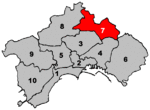Di Vittorio (Naples Metro)
Naples Metro stationsRailway stations in Italy opened in the 21st century
Di Vittorio will be a station on Line 1 of the Naples Metro and on Line 11 (also known as the Rainbow Line or the Naples-Aversa Line) of the railway network managed by EAV (formerly MCNE). It is located in the Secondigliano district, between Piazza Giuseppe Di Vittorio (also known as Piazza Capodichino) and Viale Comandante Umberto Maddalena (also known as Doganella).
Excerpt from the Wikipedia article Di Vittorio (Naples Metro) (License: CC BY-SA 3.0, Authors).Di Vittorio (Naples Metro)
Viale Comandante Umberto Maddalena, Naples Secondigliano
Geographical coordinates (GPS) Address External links Nearby Places Show on map
Geographical coordinates (GPS)
| Latitude | Longitude |
|---|---|
| N 40.8806 ° | E 14.2743 ° |
Address
Di Vittorio
Viale Comandante Umberto Maddalena
80144 Naples, Secondigliano
Campania, Italy
Open on Google Maps






